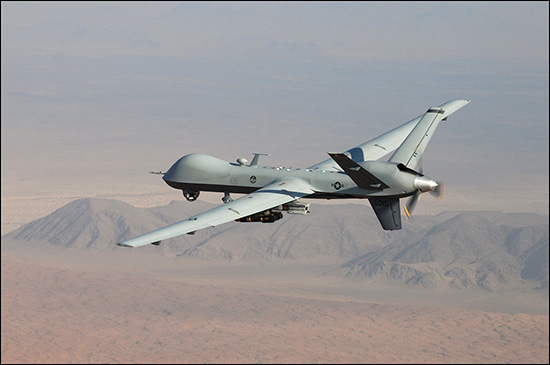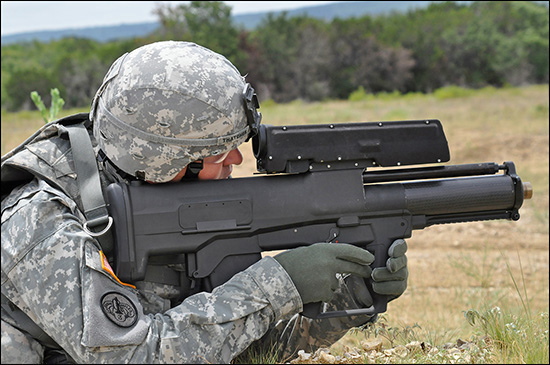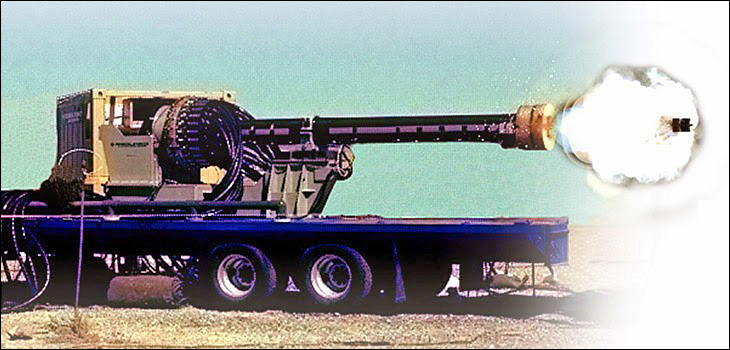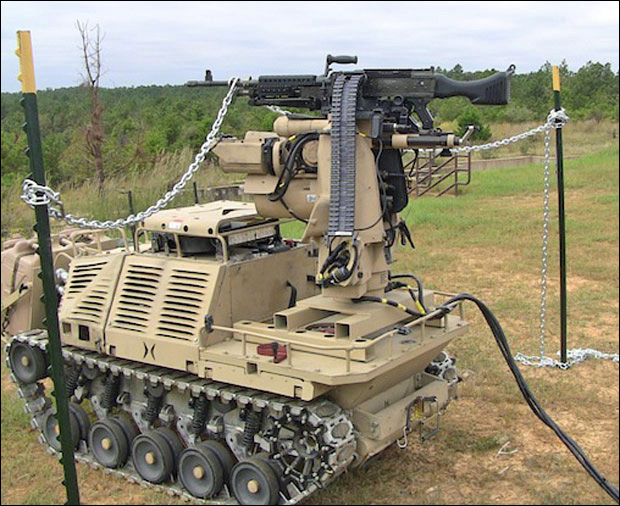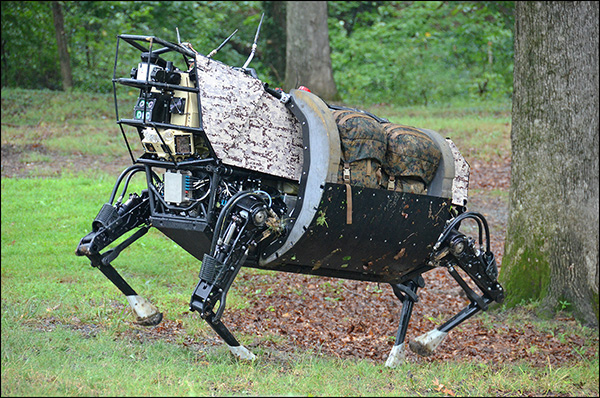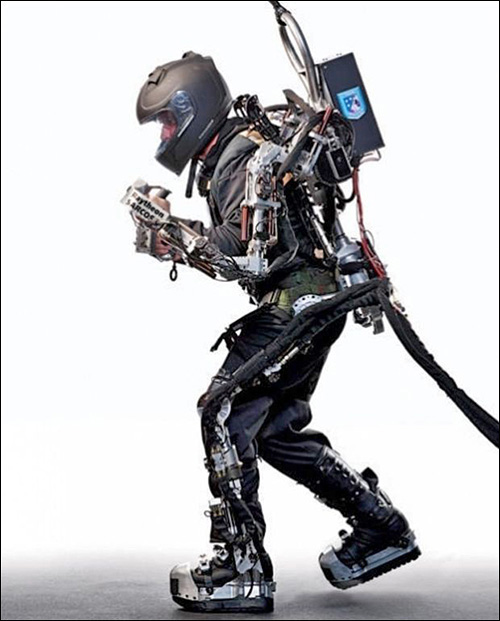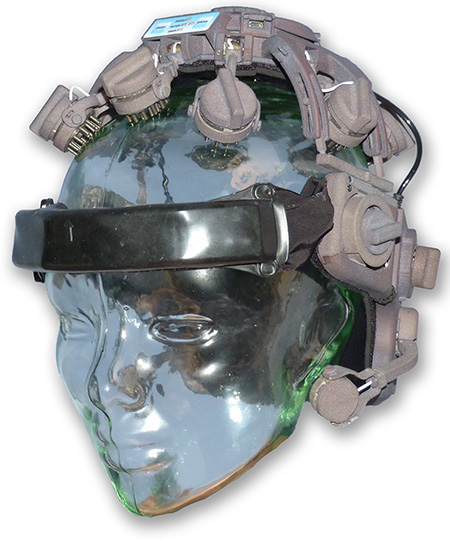10. Smart Warfare: Rise of the Machines
Missile-equipped drones. Smart bullets. Laser guns. Robot soldiers.
While we’re not yet living in the science fiction world of self-aware killer robots, the face of combat is certainly changing. We have the Internet of Things (IoT) to thank—or blame—for that.
The Past, Present, Future of Tech-Based Warfare
Science fiction has imagined a variety of dystopic futures. That seems to be part and parcel of the genre. Malevolent robots, giant mechanical killing machines, particle-beam weapons—that sort of thing. The type of battlefield you see in Terminator and Star Wars—combat where human beings are little more than cannon fodder for the cyborgs and robotic weapons controlled from afar by digital commanders.
Technology has always influenced warfare and vice versa; much technological development has arisen during times of war. From catapults and cannons to jet fighters and atomic bombs, tech and combat go hand in hand.
Three Generations of Warfare
Military experts define three distinct generations of warfare, with a fourth generation looming on the horizon. Each generation is defined by the technologies and strategies employed.
The first generation of warfare was that of line-and-column combat. This is the type of combat common up to and including the Napoleonic wars, where masses of soldiers on both sides of the conflict lined up (in those rows and columns), marched toward each other, and used the technology of the day to try to kill each other. In early days, the technology was sticks and stones, then swords and maces, then muskets and bayonets. It was a brutal, bloody, personal business, and the available weapons technology really didn’t help much.
The second generation saw the introduction of long distant battles, due in part to the development of longer range, more accurate guns and artillery. With these more advanced weapons, soldiers didn’t have to stand right in front of the enemy to kill them; killing could now be done at a distance. This is the type of combat experienced during World War I. Again, the soldiers lined up in rows and columns, but instead of marching toward each other, they dug themselves into trenches and let their new technology weapons do the killing for them. On the front lines, automatic rifles and machine guns made killing much more efficient than old-tech weapons. Behind the front lines, killing could be accomplished from afar with cannons and other artillery. Throw a little mustard gas into the mix, along with the first aerial combat vehicles, and you get slaughter on a scale previously unimaginable.
In the third generation of warfare, combatants employed speed and surprise to bypass the enemy’s lines and collapse their forces from the rear. These tactics were made possible due to the introduction of tanks and aircraft into the battle sphere. This is the type of combat employed during World War II and all subsequent wars, up to and including the 2003 American invasion of Iraq. More distance combat, more bombing and shelling, less face-to-face or hand-to-hand fighting—culminating in what we then thought was the ultimate bomb, like the ones dropped on Hiroshima and Nagasaki.
Notice the trend of relying more and more on machinery and technology, distancing fighting from individual soldiers. Combat becomes more impersonal, more a flick of the switch or push of a button than anything directly physical.
The Fourth Generation
This leads us into the coming fourth generation of warfare, where killing is done completely by remote control, with a lessened need for hand-to-hand combat. Attacks are more targeted, whether in terms of property or people. Drones and other smart weaponry are programmed with specific targets, and that’s what they hit. There’s less mass bombing and more pinpoint missions. Targets are determined using data from high-tech surveillance devices; commanders are made smarter, leading to more informed decisions (and, presumably, fewer mass civilian casualties).
When soldiers are employed, they’re better protected and better armed. High-tech materials make for uniforms or protective shells that withstand enemy fire. Smart weapons enable precise targeting from a safe distance. State-of-the-art communications systems enable instantaneous communications between command and field, and video feeds enable commanders to see what the soldiers see in combat.
Of course, all of this military tech costs money, so fourth generation warfare is only affordable by the richest combatants. This puts poorer countries at a distinct disadvantage, but that’s been ever the case. Victory belongs to those who can afford it.
Unless, that is, the ever-decreasing cost of technology actually levels the playing field. A small remote-controlled drone aircraft capable of carrying a decent-sized payload costs a lot less money than a state-of-the-art stealth bomber. Even otherwise-low-tech insurgents have access to all the information that is on the Internet, along with the corresponding real-time, long-distance communications. Robot soldiers may still be too expensive for non-superpowers, but targeted killing machines, made available via smart technology, may quickly get into the hands of even the smallest groups of enemy combatants.
Warfare today is often asymmetric, where the military power of one side differs significantly from that of the other. This is typified by a traditional army fighting a smaller group of less-well-equipped insurgents. Give those insurgents some smart weapons, however, and the odds become even.
Smart Aircraft
Let’s start our examination of smart military technology with smart aircraft, in the form of unmanned aerial vehicles or drones. Drone aircraft, more than any other current combat technology, is changing the nature of warfare today.
We talked in depth about drones in Chapter 9, “Smart Aircraft: Invasion of the Drones.” There’s no need to repeat all that information here, so turn back if you want to learn more about Predators, Ravens, and other types of drone aircraft used by the military.
With that basic information in mind, know that military around the world see drone technology as a significant part of future conflicts, both large and small. More than 70 countries currently have drones, and drones are being used today for both reconnaissance and targeted combat missions.
The United States first used armed drones in 1995, during the Yugoslavia Civil War. In the post-9/11 era, Predator MQ-1 and more advanced MQ-9 Reaper drones have been used to kill (some would say assassinate) Al Qaeda officials and other suspected terrorists in Pakistan, Afghanistan, Somalia, and other areas of conflict.
And it’s not just the United States. Britain and Israel have used armed drones to target insurgents, Turkey is hoping to buy drones to fight Kurdish separatists, and even Iraq is investing in drones (made in the United States) to protect their oil platforms.
The biggest, baddest armed drone today is the MQ-9 Reaper from General Atomics, a San Diego-based defense contractor. The Reaper, shown in Figure 10.1, is a “hunter-killer” drone, its dual missions united to locate and then eradicate its targets. It has a 66-foot wingspan, which makes it more like a traditional aircraft in size than a radio-controlled toy plane. It’s powered by a 950-shaft-horsepower turboprop engine, has a maximum speed of about 300 mph, has a range of 3,200 nautical miles, and can fly at an altitude of 50,000 feet. Reapers carry either Hellfire missiles or more intelligent laser-guided bombs, making them especially deadly, even as they’re piloted from afar.
Deadly as they are, drones are considered by many to be more humane than more traditional missiles and bombers. They conform more closely to the Geneva Convention, in that their more targeted systems supposedly minimize collateral damage. This last point is certainly debatable; a powerful missile delivered from a Reaper or Predator is certainly big enough to wipe out more than a single person walking down the street.
Some see drones as the future of military conflict. By precision targeting opposition leaders, buildings, and equipment, large-scale military operations can be minimized or eliminated completely. Drones also eliminate friendly casualties; there are no pilots or crew to be shot down over enemy territory. And if they truly do the job of stopping conflicts before they turn massive, ground-troop casualties will also be significantly reduced.
Others see drones as doing nothing more than shifting combat responsibility from the battlefield to the headquarters (HQ)—and, potentially, from men to machines. If human troops aren’t getting their hands (as) dirty on the battlefield, if troops and commanders alike are not subject to the undeniable horrors of war, will war become more common? It’s not surprising that some of the people who object most to sending troops into unnecessary combat are those who’ve been there themselves. It’s more often military leadership that drags its heels on potential combat, while the politicians back home get all hawkish and patriotic. If our military leaders no longer have to worry about sending young men and women into dangerous situations, it’s possible that trigger-happy politicians will lead us into more conflicts. Maybe it’s just too easy to kill someone by pressing a button; maybe it needs to be more difficult than that.
![]() Note
Note
Drone strikes are not as precise as the military would like you to believe. Reprieve, a British nonprofit organization, notes that, on average, every drone strike in the Middle East kills 28 bystanders for every intended target. In the so-far fruitless quest to kill Al Qaeda head Ayman al-Zawahiri, 105 innocent individuals have been killed, 76 of them children. Traditional attacks or “targeted” drone strikes, collateral damage—in the form of innocent lives lost—still exists.
Smart Bombs
Smart military aircraft become more dangerous when they carry more intelligent and more powerful payloads.
Today’s largest drone, the MQ-9 Reaper, is big enough to carry all manner of traditional ordinance, including Hellfire missiles and 500-pound, laser-guided bombs. That’s well and good, but what if the same (or smaller) craft were loaded with nanoexplosives that delivered twice the explosive power in the same package?
Nanoexplosives use nanoparticles that have more surface area in contact between the different chemicals used in the explosive. When a reaction is initiated, this extra surface area causes a faster reaction rate, which makes for a more powerful explosion. The upshot is that you can make a given-sized bomb twice as powerful, or get the same explosive force with a bomb only half as large—the latter being an attractive option when dealing with smaller and lighter drones.
As to smarter bombs, your tax dollars are funding research into this as well. A smart bomb, also called a guided bomb, is one that uses precision guidance systems to hone in on the intended target. These weapons are theoretically capable of being guided—either autonomously or via remote operator—directly to the target, thus ensuring more effective operation with less collateral damage.
These smart munitions, such as Boeing’s GPU-31 Joint Direct Attack Munition (JDAM) and Raytheon’s GBU-39 Small-Diameter Bomb (SDB), are similar to drone aircraft, in that they’re unmanned and employ intelligent systems to guide the weapons to their targets. The JDAM employs global positioning system (GPS) technology for more precise targeting, while the SDB, shown in Figure 10.2, uses a combination of radar, infrared, and laser signals for guidance.
What you get with both these systems is a bomb that is guaranteed to hit its target, and not something a mile or so away. Traditional bombs are notoriously dumb; you drop them out of a plane and assume they hit something valuable when they reach the ground. Smart bombs, like the JDAM and SDB, can be directed at very precise targets and hit them. We’ve all seen the grainy video footage of a smart bomb in the first Iraq War aiming for and then barreling down the smokestack of a targeted building. The technology enables a higher success rate and fewer near misses.
![]() Note
Note
Because both of these weapons use radio frequency (RF) technology, they can be confused and thrown off course with radio-jamming technology. Which is why the Air Force is also working on what is called home-on-jam technology. When a jamming signal is detected, the home-on-jam technology takes over and flies the weapon directly to the source of the signal. Thus, the jamming signal becomes the opponent’s demise.
Smart Weapons
Smart technology isn’t limited to larger munitions. There’s a whole generation of smart personal combat weapons either here now or on its way. We’re talking smart guns and smart bullets, folks.
For example, the XM25 Counter Defilade Target Engagement (CDTE) System, shown in Figure 10.3, is a smart sniper’s rifle (designed by Alliant Tech Systems and Heckler and Koch) that uses smart bullets programmed to explode when they’ve traveled a set distance. This enables the sniper to either hit the target directly or flush out the opponent, by exploding above or beside the bad guy.
Here’s how it works.
The soldier shines a laser rangefinder at the enemy combatant, which then calculates the distance to the target. The bullet can be programmed to hit the target directly or to explode above or beside the target. Each bullet has a timed fuse, as well as a small magnetic transducer that interacts with the Earth’s magnetic field. This transducer generates a small alternating current every time it spins, and the miniature computer inside the bullet counts the number of rotations it makes. When the bullet has flown the designated distance, the computer issues the instruction to detonate, releasing a burst of shrapnel.
Future weapons will enable soldiers to hit targets up to 1,000 yards away without any specialized training. This is due to developing technology from TrackingPoint, an Austin-based company specializing in smart rifle technology. A TrackingPoint system pairs a Linux-powered scope with a guided trigger; not only can distant targets be dialed in with a minimal amount of effort or skill, a live feed of what the shooter sees can be fed back to commanding officers. To give you an example of how effective this technology can be, a typical soldier only has 20 percent accuracy with targets 1,000 yards distant; with TrackingPoint technology, the accuracy jumps to 70 percent. With this kind of smart shooting, you don’t need trained snipers to make the kill.
Then there’s the new type of weapon called a railgun. This is an electromagnetic projectile launcher, capable of accelerating heavy projectiles at hypersonic speed. It’s built around a pair of parallel conducting rails, over which a sliding armature is accelerated via the electromagnetic effects of a current that flows down one rail, into the armature, and then back along the other rail. This flings the armature, carrying an explosive payload, down the rail and into the air.
A railgun has several advantages over a traditional battlefield missile. First, you don’t need any propellant; the missile flies off the rail, propelled solely by the electromagnetic pulse. Second, the missile doesn’t need to be packed with high explosives; it’s traveling so fast (up to Mach 7—seven times the speed of sound) that its speed alone makes it highly lethal. Third, railgun systems employ guided projectiles, so they’re extremely accurate.
Railguns are well into the developmental phase. For example, General Atomics’ Blitzer railgun, shown in Figure 10.4, is expected to be ready for production by 2016. It can be used either on land or on the sea, to knock out enemy battleships.
There’s more. The U.S. military is working on real honest-to-goodness laser guns that look more like Star Trek than anything in use today. Particle-beam weapons will focus a high-energy beam of subatomic particles to disrupt the target’s molecular structure. And electromagnetic pulse weapons will be capable of knocking out all of an enemy’s electrical systems, from computers to car engines, without destroying life or property.
Fascinating and scary stuff, brought to you courtesy of your local military-industrial complex. That said, these weapons promise to make combat more deadly for the enemy, while at the same time safer for troops on our side.
Robot Soldiers
If you want to get into real science fiction territory, consider the robotization of combat. We’re talking everything from mechanical combat suits to full-blown battlefield robots. Robotic battlefield technology promises to make combat more survivable for the grunts on the ground, as well as reduce the number of soldiers needed to fight.
Sound far-fetched? Then talk to General Robert Cone, Commander of the Army Training and Doctrine Command (TRADOC). He’s looking at shrinking the size of the combat brigade from about 4,000 soldiers to 3,000 and filling the gap with robots.
That’s right. Robots.
![]() Note
Note
Experts note that replacing human soldiers with robots will save lives (at least on our side). The motivation isn’t all humanitarian, however. Building robot soldiers, at least in the long run, will be cheaper than training, feeding, and caring for human soldiers. It’s an economic decision as well as a strategic one.
Today’s Army Robots
Let’s start our look at robotic warfare by looking at the robots employed by the U.S. Army today. There are a few—although most are rather primitive in their construction and functionality.
First, there are bomb-squad robots. These little robotic devices were used in both Iraq and Afghanistan to dispose of improvised explosive devices (IEDs), those deadly roadside bombs. Better to have a robot try to diffuse an IED—and possibly get blown up doing so—than risk the life of a human member of the bomb squad.
The Army has also tested several remote-controlled, machine gun-firing robots. One of the more promising units is the Protector, from HDT Global Dynamics. As you can see in Figure 10.5, the Protector is a small (three-foot wide) tank-like unit with an M240 machine gun mounted on top. All the operating mechanisms are protected in the tank part of the unit, which can carry 1,350 pounds of gear. The diesel-powered, 32-horsepower engine enables it to climb 45-degree slopes with ease.
The Protector is operated via wireless remote control, up to 3,280 feet away. The operator uses a controller that looks a lot like a videogame controller, with two buttons and a thumbstick. It also includes a “cruise control” button that enables the robot to prowl on its own power, maintaining the current speed and direction. It can also be equipped with various attachments for other duties, including a backhoe and mine roller/rake.
Then there’s the Legged Squad Support System, or LS3, a robotic pack mule from Boston Dynamics (now a Google company). As you can see in Figure 10.6, the LS3 looks a little like the All Terrain Armored Transport (AT-AT) walkers in the Star Wars movies, but on a considerably smaller scale.
The LS3 has four legs and walks kind of like a dog. (Check YouTube for a video; it’s kind of creepily fascinating.) It can carry 400 pounds of supplies, follow squad members through rugged terrain, and interact with troops in a semi-autonomous fashion, much like a trained animal interacts with its handler.
![]() Note
Note
The LS3 is nicknamed AlphaDog, and follows on its predecessor, the aptly named BigDog.
There are presently several autonomy settings in the LS3’s programming which affect how it follows along with its squad. For example, in Leader-Follower Tight mode, the LS3 attempts to follow its leader as closely as possible. In Leader-Follower Corridor mode, the LS3 sticks to the leader but has the freedom to make localized path decisions. In Go-to-Waypoint mode, the LS3 ignores the leader and uses its sensors to avoid obstacles on the way to a designated coordinate.
The whole point of the LS3 system is to relieve troops of some of the burden of carrying supplies. This will help troops move faster and have more endurance in the field.
Robotic Armor and Super Soldiers
Human beings are regrettably fragile. Not only do we Homo sapiens tire quickly and require 8 hours or so of rest each day, we’re also quite vulnerable to damage from bullets, grenades, bombs, and similar things. That makes for high numbers of casualties in combat, which is a bad deal not only for those who are injured or killed, but also for their commanders who must continue replenishing the ranks with fresh troops.
What if there were a way to make humans a little less vulnerable? To enhance not only their survivability but also their abilities? What if we could use technology to create an army of super soldiers, capable of marching longer without rest, suffering fewer injuries, and having more and stronger offensive powers?
Not surprisingly, the U.S. government is working on just such a thing. And the technology is almost there.
The simplest(!) approach is to encase soldiers in robotic armor. We’re talking some sort of powered mechanical exoskeleton (for enhanced strength and protection) combined with wearable computers, communications gear, and smart weapons.
The exoskeleton is powered by a system of motors and hydraulics that enhance the wearer’s strength, powering at least part of the limb movement. This will enable the wearer to carry heavier loads both in and out of combat. The exoskeleton will also help the wearer survive in dangerous environments—and absorb the shock of bullets and explosions. It’s kind of like the Iron Man suit, but without Tony Stark inside.
The military has commissioned several prototypes of powered exoskeletons, including the Human Universal Load Carrier (HULC—get it?) from Lockheed Martin and the XOS from Raytheon. The XOS, shown in Figure 10.7, weighs about 200 pounds, is constructed from high-strength aluminum and steel, and uses a variety of controllers, sensors, and actuators to perform necessary tasks. The powered limbs enable the wearer to lift more than 200 pounds of weight without feeling any strain.
The exoskeleton is for protection and enhanced strength. It needs to be accompanied by some sort of control mechanism, probably mounted in the soldier’s helmet. Consider such a helmet with accompanying visor that contains a heads-up virtual display, night-vision capability, and wireless headset and microphone. The soldier turns to look at a target, locks onto that target with the heads up display, says “Fire!,” and sees the target go down in front of him.
The next step is to augment soldiers’ bodies with robotic technology. This would turn the average soldier into a bit of a cyborg—a “cybernetic organism,” if you will. This approach, while definitely science fiction-y, promises the best of both worlds; you get the durability, strength, and precision of robotic systems combined with the superior cognitive abilities of the human brain.
This is serious stuff here. We’re talking a combination of neuroscience, nanomedicine, robotics, computer technology, and a whole lot more. Tapping into soldiers’ brains so they can control their robotic armor and weapons systems through the power of thought. Melding mechanical systems with biological ones. Creating a super soldier whose mind and body are one with his armor and weapons.
Such a cyborg soldier will be capable of fighting in all manner of extreme environments, from the cold of Siberia to the heat of the Iraqi desert. He will have the endurance to remain in the field for extended periods of time. Embedded nanosensors will constantly monitor his medical status, nanoneedles will release drugs when needed, and nanorobots will quickly heal his wounds. Optical implants will enable him to see in the darkest night, to view the enemy via infrared light, and extend his vision thousands of feet. He will be a super man.
Our future cyborg soldier will still need his robotic armor, of course. Embedded into this armor will be advanced intelligent weapons systems. A rapid-fire machine gun melded onto one arm, a precision long-range sniper’s rifle or even a laser rifle on the other. Shoulder-mounted missile launchers. A stock of smart bullets and smart missiles ready for automatic reloading. The necessary communications systems embedded into his helmet. Everything he will need in the field attached to his armor. A one man fighting machine, controlled by that one man’s human intelligence.
Yes, it sounds far-fetched. But it’s all in development today.
Take, for example, the Cognitive Technology Threat Warning System (CT2WS), a helmet-mounted, threat-detection system, shown in Figure 10.8. This system consists of three parts. The first part is the electroencephalogram (EEG) headset that uses wireless sensors to monitor electrical activity in the brain, looking for a specific brainwave that results when the subconscious detects a visual threat. The second part is an electro-optical video camera with a 120-degree field of view that scans the surroundings. And the third part is the computer system, to which both the EEG unit and camera are connected; it uses proprietary algorithms to assess the threat level and identify potential targets. Initial tests show that this system identifies 91 percent of enemy targets, as opposed to just 41 percent identified by nonaugmented humans.
And there’s more to come. Any volunteers?
Autonomous Fighting Robots
We’re a long way from developing cyborg soldiers to do our fighting for us. The progress is slow, even with the backing of the Defense Advanced Research Projects Agency (DARPA—the same folks who developed the Internet). There are all sorts of hurdles to overcome, from computing power to the necessary portable power sources to all the neuro-biological issues. And even when we develop the perfect super soldier, there will still be a human being inside—and human beings are still human, after all.
The ultimate fighting machine, then, will probably be just that—a machine. Our pals at DARPA have been funding robot research for years, with the goal of creating a robot army that can do our fighting for us, via either remote control or autonomous operation.
Consider DARPA’s Atlas robot, shown in Figure 10.9, created by Boston Dynamics (the same folks behind the AlphaDog). Atlas is 6 foot 2 inches tall, humanoid in design, and is a biped—that is, he walks on two feet, like you and me. This leaves his arms free to lift and carry things, as well as perform other tasks with his articulated robotic hands.
Atlas was purportedly developed for disaster response and currently sports no built-in weapons systems. But it’s not a stretch to see this big guy adapted for combat use at some time in the future. It’s what the folks at DARPA tend to do.
Current technology has a long way to go, however, for robots to become effective battlefield fighters. In particular, the robots have to get a lot smarter so that they can perform autonomously in the field; one simply can’t imagine a battalion of 4,000 marching robots being remotely controlled by 4,000 human operators. The robots have to “think” on their own and adapt to the ever-changing conditions of combat.
But we don’t want them to get too smart. The idea of robots developing sentience is the stuff of science fiction (think the Skynet system in the Terminator movies), but a very real possibility. We really don’t want our killing machines gaining self-awareness and staging some sort of cybernetic revolt. This means putting some sort of limits on artificial intelligence technology, or embedding strong and effective constraints on the machines’ autonomy circuits. Or something like that.
![]() Note
Note
The point where a computer’s artificial intelligence exceeds human intellectual capacity (and control) is called the singularity event. Resulting events beyond this singularity are impossible to predict, but probably won’t be good for humankind—do we really want our machines to be smarter than we are?
Smart Strategy
Perhaps more important than smart weapons and cybernetic soldiers is the decision-making that is crucial to all combat operations. The more information military commanders have, the better the decisions they’ll make.
Here is where the Internet of Things will make a real difference in how future wars are conducted. The IoT is all about smart things—and collecting massive amounts of data.
Information gathering and analysis is the key to future warfare. Imagine everything combat troops experienced beamed back in real-time to HQ. Imagine satellites transmitting high-resolution images in real time. Imagine information-gathering drones and ground robots, feeding their data back to HQ. Imagine insect-sized devices flying into the enemy zone, undetected, each sending small amounts of data that can be combined and collated to give commanders a near-perfect view of what the opposition is up to.
Now imagine the intelligent systems capable of receiving, analyzing, and acting on all this data. Systems that can identify and summarize the important data for the generals to act on. Systems that can even act autonomously on the data, making decisions without the involvement of the military brass. Battles conducted based on data and logic rather than human emotion. Preemptive strikes that halt combat before it starts.
It all starts to look a little like some computer war game. Maybe humans won’t be involved at all—our computers will battle their computers in some virtual space, and we’ll get a text message informing us who won. Why not? It’s got to be better than the way we conduct our wars today.

